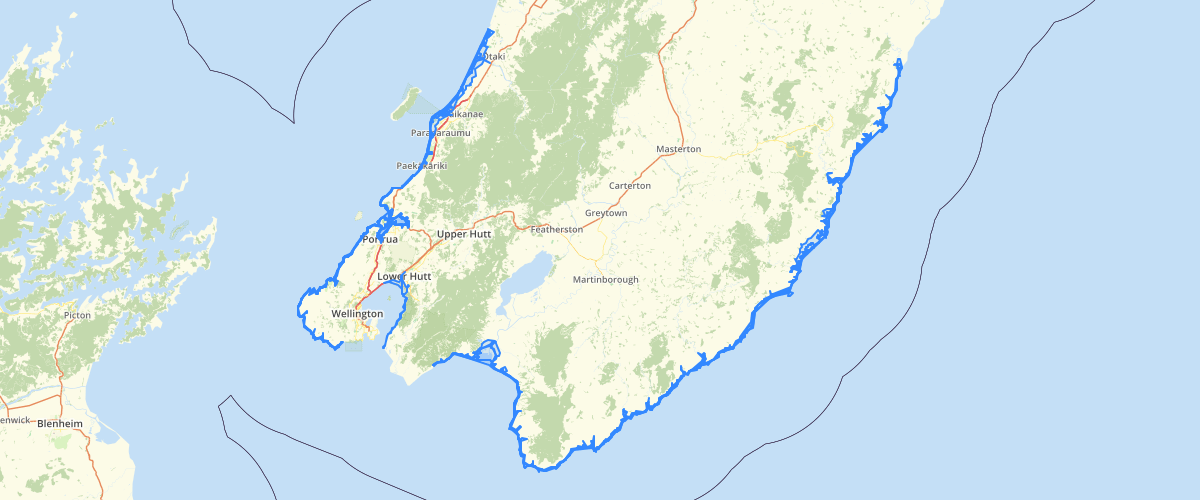Wellington Regional Council Wellington Region Tsunami Evacuation Zones
Request AccessWellington Regional Council - Wellington Region Tsunami Evacuation Zones, Tsunami evacuation maps containing three zones; red, orange and yellow, corresponding to different threat levels for the development of tsunami evacuation plans, public awareness, self evacuation and official civil defence emergency management or emergency services evacuations in the event of a tsunami. The zones were digitised onto orthophoto coverage based on raw polygon data derived from two tsunami modelling projects. The first of these was a regional modelling project undertaken in 2008 using an empirical 'rule-based' tsunami height attenuation modelling technique. The second project was a more detailed hydrodynamic inundation modelling of Wellington Harbour undertaken in 2015. The regional modelling used an attenuation relationship to model the onshore and upstream runup of tsunami flow to derive the horizontal distances and vertical elevations. The relationship was based on and calibrated with observations of tsunami runup elevations from known events. The relationship is 0.5% height attenuation by distance (i.e. water gets 1.0 m shallower every 200 m inland). The relationship is different for flow over water and up rivers where height attenuation was set at 0.25% (i.e. water gets 1.0 m shallower every 400 m upstream). Only rivers with a width at the mouth over 10 m were modelled in this way. Two zones were modelled with this attenuation relationship; the orange zone and the yellow zone. The red zone was derived by orthophoto analysis, complemented with LiDAR data. The input data for the GIS modelling consisted of a digital elevation model in ArcINFO grid format derived from LiDAR data coverage for the western half of the region (Hutt, Wellington, Porirua, Kapiti) and an interpolated DEM from the 1:50000 LINZ topographic NZMS-260 series for the Wairarapa Coast. Individual grids were generated for significant river and lakes to model the attenuation rule over water and a sea polygon coverage was created from the coastline as an inundation source. The modelling was calibrated with probabilistic tsunami wave heights derived from previously recorded events that have affected the Wellington region and modelling tsunami from known source areas. The second project was a more detailed hydrodynamic inundation modelling undertaken using the COMCOT tsunami model developed by GNS tsunami scientists. The area covered includes Wellington Harbour including Lower Hutt, Eastbourne and east Harbour Bays, Wellington City and south coast bays, Lyall, Houghton,Island and Owhiro Bay. More detailed modelling was possible due to high-resolution topographic and bathymetric data becoming available of the area from projects co-funded by Greater Wellington Regional Council, advances in the understanding of tsunami flows within enclosed harbours and research undertaken by GNS Science on the rupture characteristics of the Hikurangi subduction zone – the offshore plate boundary of the Australian and Pacific tectonic plates. The red zone, also known as the shore exclusion zone, can encompass wave heights up to 1.2 m in height with a 1% annual exceedance probability (i.e. 100 yr return period) from all sources (local, regional and distant). The red zone is to be used when a tsunami forecast suggests a marine threat or a threat only to beaches and coastal infrastructure and facilities. The orange zone was defined using probabilistic wave heights with a 0.2% AEP (i.e. 500 yr return period) from regional (1-3 hr travel time away) and distant sources (>3 hr travel time away). For Wellington Harbour this encompasses tsunami waves heights up to 5.0 m. The orange zone is to be used when a forecast tsunami from a distant source is expected to cause some inundation, but not large enough to require evacuating the yellow zone. The yellow zone was defined using probabilistic wave heights with a 0.04% AEP (i.e. 2500 yr return period) from all possible sources and corresponds to the maximum credible event for the region and up to a 6000 yr return period for Wellington Harbour based on a Mw 9.0 earthquake on the Hikurangi Subduction Zone. The yellow zone is primarily for self-evacuation in the event of a strongly-felt or long-duration earthquake, or when a forecast of a distant-source tsunami of above a specific threat level is issued. Further information can be found in the reports: Leonard, G.S., Power, W., Lukovic, B., Smith, W., Johnston, D. and Downes, G. (2008), Tsunami Evacuation Zones for Wellington and Horizons Regions Defined by a GIS-Calculated Attenuation Rule. GNS Science Report 2008/30, 22 p. Mueller, C., Power, W.L. and Wang, X. (2015), Hydrodynamic Inundation Modelling and Delineation of Tsunami Evacuation Zones for Wellington Harbour. GNS Science Consultancy Report 2015/176, 30 p.

Sample Properties
- {} 9 keys▶
- 264
- 3
- "yellow"
- "Porirua coast"
- "Local source tsunami < 1hr travel time (large local earthquake)"
- "7-8 m wave - runup elevations approx. 15 m above MHWS"
- 3616541.211130145
- 143444.3296277114
- "Self Evacuation Zone"
